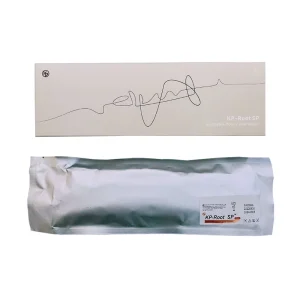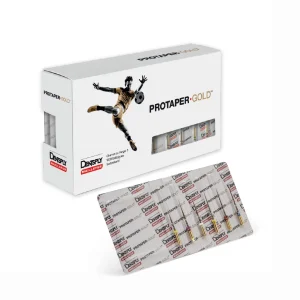- Enhanced Metallurgy (ProTaper GOLD)
- Multiple Changing Tapers over each File’s Cutting Blades
- Convex Triangular Cross Section
- Progressively Changing Helical Angle and Pitch
- Variable Tip Diameters
- Modified Guiding Tip
- No Radial Lands
- More Efficient Cutting Angle
- Improved Safety
- Short Handles
- Eight (8) Instrument Series
Description
Dentsply Protaper Gold Rotary Files 25mm are a state-of-the-art rotary file system designed for shaping and finishing root canals in dentistry. These files are built with cutting-edge metallurgy, offering dental professionals unparalleled flexibility and predictable performance. They have a trusted legacy in the dental industry and are known for their precise and efficient root canal procedures. One of the key advantages of Dentsply Protaper Gold Rotary Files is their ability to reduce the risk of file separation. File separation during root canal procedures can be a significant challenge, leading to additional complications and treatment delays. By incorporating advanced technology and proven geometries, these files minimize the chances of file separation, ensuring smoother and safer procedures. The seamless transition for ProTaper Universal users is another notable feature of the Dentsply Protaper Gold Rotary Files. This means that dental professionals who have been using ProTaper Universal files can easily adapt to the Protaper Gold system without extensive retraining or workflow changes. This compatibility enhances the level of trust among clinicians globally, making it a preferred choice for many.
Key Specifications
TECHNICAL SPECIFICATIONS:
| ProTaper Gold | ||
| File Size | Speed [rpm] | Torque [N•cm] |
| ProTaper Gold S1 & SX | 300 | 5.1 |
| ProTaper Gold S2 & F1 | 300 | 1.5 |
| ProTaper Gold F2, F3, F4, F5 | 300 | 3.1 |
Packaging
- Pack of 6 Files
Direction to Use
- Preparation: Ensure that you have the necessary personal protective equipment (PPE) such as gloves, mask, and eyewear. Set up the dental operatory with the appropriate instruments and materials for a root canal procedure.
- Access and irrigation: Create access to the root canal system using standard dental drills and burs. Establish a proper irrigation protocol using an irrigating solution like sodium hypochlorite or chlorhexidine to disinfect and lubricate the canal.
- Initial negotiation: Begin the negotiation of the canal using hand files to determine the working length and confirm the patency of the canal. Use hand files to remove any obstructions or debris.
- Selection of Protaper Gold files: Choose the appropriate Protaper Gold files based on the anatomy of the canal. The Protaper Gold system typically includes a series of files with different tapers and tip sizes to progressively shape and enlarge the canal.
- File insertion: Insert the selected Protaper Gold file into the canal. Ensure that the file is properly aligned with the canal axis and gently advance it using a pecking motion. Avoid applying excessive pressure to minimize the risk of file separation.
- Rotary motion: Activate the rotary motion of the file using a compatible endodontic motor or handpiece. Follow the manufacturer’s instructions for setting the speed and torque limits recommended for Protaper Gold files.
- Shaping and finishing: With the rotary motion engaged, use the Protaper Gold file to shape and enlarge the canal. Move the file in a smooth and controlled manner, allowing it to progressively shape the walls of the canal.
- Irrigation and debris removal: Regularly irrigate the canal with the chosen irrigating solution to remove debris and maintain a clean working environment. Use a gentle pumping motion to facilitate the flow of the irrigant throughout the canal.
- File progression: As you progress through the different Protaper Gold files, follow the predetermined sequence recommended by the manufacturer. Each file will have a specific function in shaping and preparing the canal for obturation.
- Finalization: Once the desired canal shape and size are achieved, complete the root canal procedure by thoroughly cleaning and shaping the apical portion of the canal. This may involve using smaller hand files or specialized instruments.

















Reviews
There are no reviews yet.